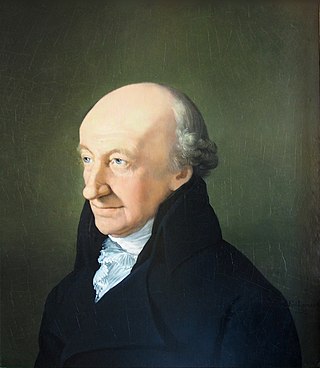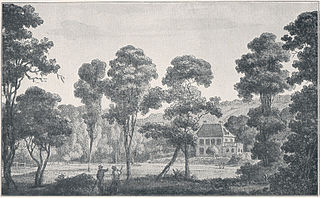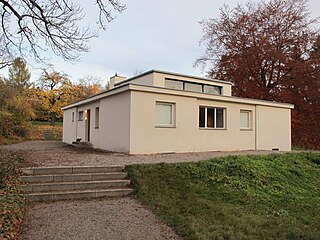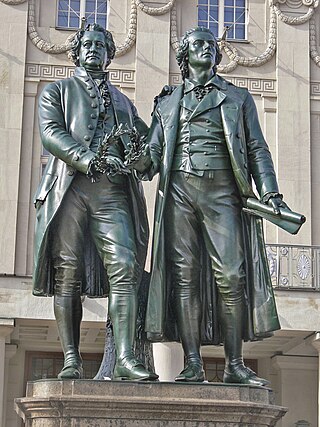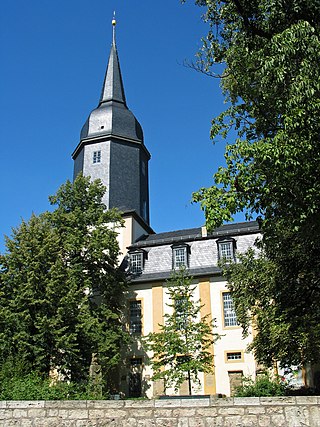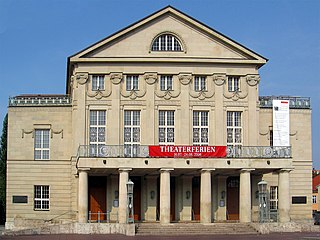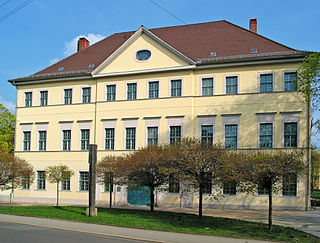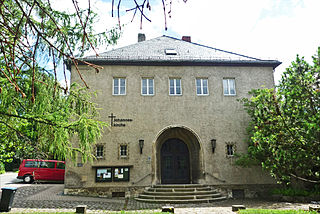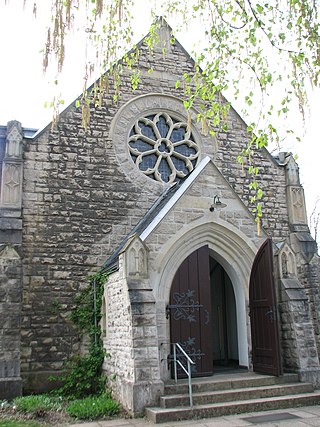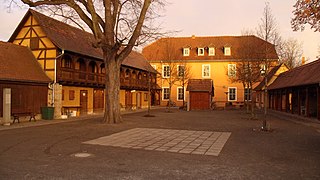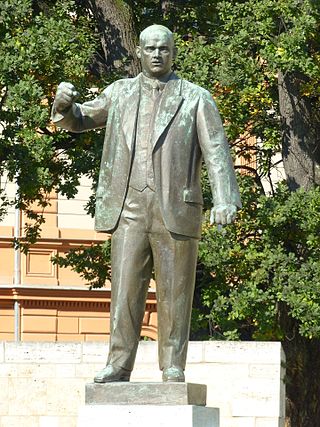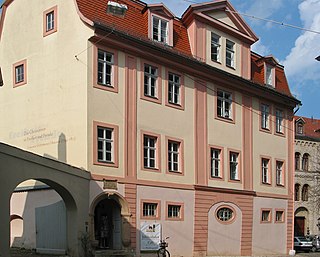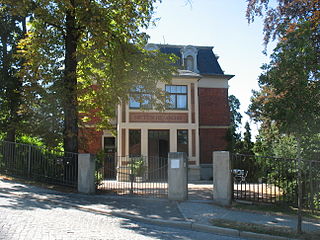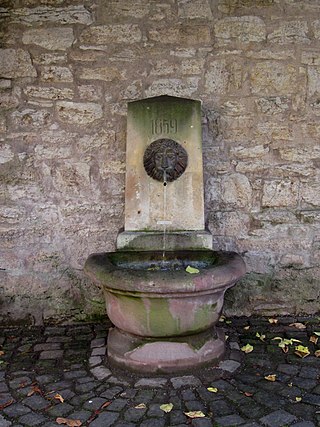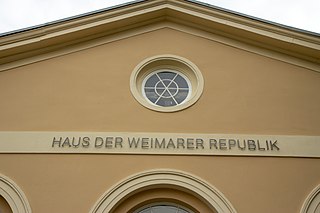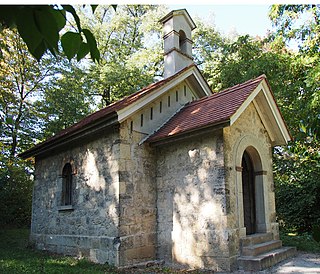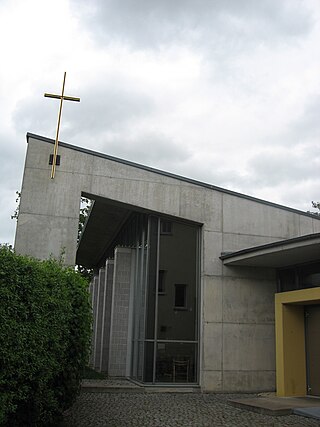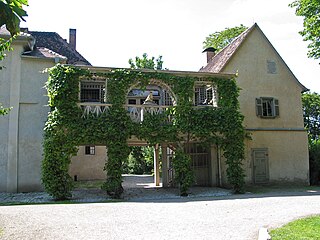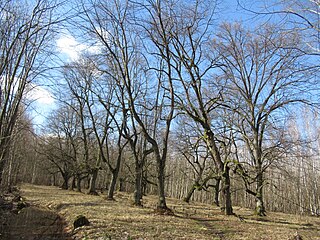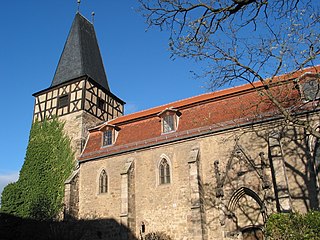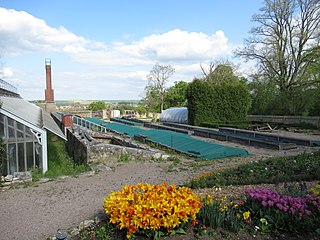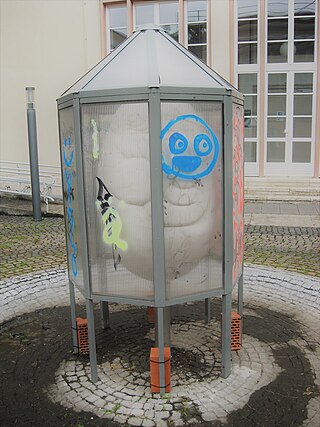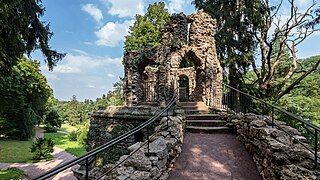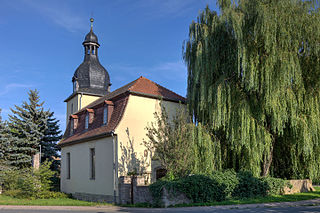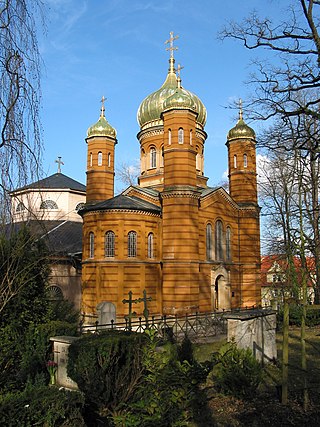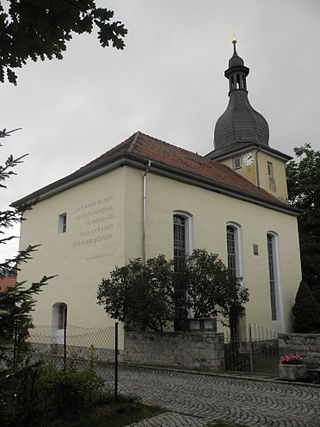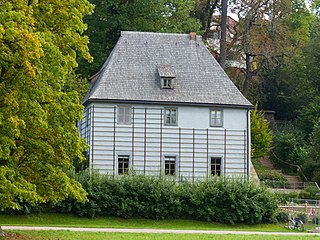50 Sights in Weimar, Germany (with Map and Images)
Legend
Premium Sights
Book tickets, guided tours and activities in Weimar.
Guided Free Walking Tours
Book free guided walking tours in Weimar.
Welcome to your journey through the most beautiful sights in Weimar, Germany! Whether you want to discover the city's historical treasures or experience its modern highlights, you'll find everything your heart desires here. Be inspired by our selection and plan your unforgettable adventure in Weimar. Dive into the diversity of this fascinating city and discover everything it has to offer.
Sightseeing Tours in Weimar1. Buchenwald Memorial
Buchenwald was a Nazi concentration camp established on Ettersberg hill near Weimar, Germany, in July 1937. It was one of the first and the largest of the concentration camps within the Altreich. Many actual or suspected communists were among the first internees.
2. Ochsenauge (Leutraquelle)
The Leutra Springs are three karst and fault springs of the Leutra in the Park an der Ilm in Weimar. The source is located on the right side of the Ilm south of the Sternbrücke at the foot of the Horn. Two of the springs were artistically designed at the end of the 18th century as a sphinx grotto and as a so-called ox eye. The Sphinx Grotto was built in 1784 at the behest of Duke Carl August by Martin Gottlieb Klauer, who created it according to designs by Georg Melchior Kraus. The ensemble is one of the oldest facilities in the park and is now part of the World Heritage Site "Classical Weimar".
3. Christoph Martin Wieland
Christoph Martin Wieland was a German poet and writer, representative of literary Rococo. He is best-remembered for having written the first Bildungsroman, as well as the epic Oberon, which formed the basis for both Friederike Sophie Seyler's opera of the same name and Carl Maria von Weber's opera of the same name. His thought was representative of the cosmopolitanism of the German Enlightenment, exemplified in his remark: "Only a true cosmopolitan can be a good citizen." He was a key figure of Weimar Classicism and a collaborator of Abel Seyler's theatre company.
4. Liszt-Haus
The Liszt House Weimar is the former home of the composer and pianist Franz Liszt in Weimar, which is now used as a museum. The house is located at Marienstraße 17 in front of the beginning of Belvederer Allee south of Weimar city centre on the edge of the Ilmpark.
5. Herz-Jesu-Kirche
The Roman Catholic parish church of the Sacred Heart of Jesus is located in the Thuringian city of Weimar. It is the parish church of the parish Herz Jesu Weimar in the Weimar deanery of the Diocese of Erfurt. It bears the patronage of the Sacred Heart of Jesus.
6. Schillers Wohnhaus
The Schiller House Weimar is a museum operated by the Klassik Stiftung Weimar in the former home of Friedrich Schiller (1759–1805) in Weimar. In 1988, the new building of the Schiller Museum was erected behind the house, which is now used for special and temporary exhibitions of the Klassik Stiftung Weimar.
7. Goethes Gartenhaus
Goethe's garden house in the park on the Ilm in Weimar was a home and workplace of Johann Wolfgang von Goethe. Since 1998, it has been a UNESCO World Heritage Site as part of the "Classical Weimar" ensemble. The Corona-Schröter-Weg runs past this. It stands at the foot of the Horn.
8. Haus am Horn
The Haus am Horn is a domestic house in Weimar, Germany, designed by Georg Muche. It was built for the Bauhaus Werkschau exhibition which ran from July to September 1923. It was the first building based on Bauhaus design principles, which revolutionized 20th century architectural and aesthetic thinking and practice.
9. Goethe-Schiller-Denkmal
The original Goethe–Schiller Monument is in Weimar, Germany. It incorporates Ernst Rietschel's 1857 bronze double statue of Johann Wolfgang Goethe (1749–1832) and Friedrich Schiller (1759–1805), who are probably the two most revered figures in German literature. The monument has been described "as one of the most famous and most beloved monuments in all of Germany" and as the beginning of a "cult of the monument". Dozens of monuments to Goethe and to Schiller were built subsequently in Europe and the United States.
10. Jakobskirche
The Jakobskirche in Weimar is a church building of the Baroque period. Johann Wolfgang von Goethe and Christiane Vulpius were married in her sacristy. The associated Jakobsfriedhof houses the graves of Lucas Cranach and Friedrich Schiller, among others.
11. Wittumspalais
The Wittumspalais is a museum in Weimar, Germany, run by the Klassik Stiftung Weimar. The building was the widow's residence of Duchess Anna Amalia for many years and formed a centre of social and literary life in Weimar during her lifetime. It is located between Theaterplatz, Schillerstraße, the Zeughof and the Geleitstraße. The access road from there past the Franciscan monastery in the middle of the old town is called Am Palais.
12. Fakultät Architektur und Urbanistik- Hauptgebäude
The Grand-Ducal Saxon Art School, Weimar was founded on 1 October 1860, in Weimar, Germany, by a decree of Charles Alexander, Grand Duke of Saxe-Weimar-Eisenach. It existed until 1910, when it merged with several other art schools to become the Großherzoglich Sächsische Hochschule für Bildende Kunst. It should not be confused with the Weimar Princely Free Drawing School, which existed from 1776 to 1930 and, after 1860, served as a preparatory school.
Wikipedia: Grand-Ducal Saxon Art School, Weimar (EN), Website, Heritage Website
13. Hetzerhalle
Hetzerhallen are column-free halls with a roof structure made of special laminated beams, which were named after their inventor, the master carpenter and timber construction entrepreneur Otto Hetzer (1846–1911).
14. Deutsches Nationaltheater und Staatskapelle Weimar
The Deutsche Nationaltheater und Staatskapelle Weimar (DNT), or German National Theater and Weimar State Orchestra, is the most significant arts organization in Weimar. The institution unites the Deutsches Nationaltheater with the Staatskapelle Weimar. It plays on a total of six stages across the city. All sections of the theater and orchestra periodically give additional guest performances and appear in electronic media.
Wikipedia: Deutsches Nationaltheater und Staatskapelle Weimar (EN), Website
15. Museum für Ur-und Frühgeschichte Thüringens
The Museum of Prehistory and Early History of Thuringia in Weimar combines a museum with a 1000 m² exhibition area and the Thuringian State Office for the Preservation of Monuments and Archaeology under one roof, which is the sponsor of the museum. The entrance to the museum is in Amalienstraße.
Wikipedia: Museum für Ur- und Frühgeschichte Thüringens (DE), Website, Website
16. Musentempel
The Musent temple with a Kalliope by Martin Gottlieb Klauer on a square base in the middle was built in 1803 in the 21 hectare castle park at Weimar. The fact that Klauer says Kalliope and not Polyhymnia emerges from his Toreutik catalog. The polyhymnia also has a lyra here, but the Kalliope with the same posture as the one in Tiefurt, on the other hand. In addition to the tea house, it is one of the most important components of the Parkkarchitecture of Tiefur. However, he had already prompted Anna Amalia and built in 1784, which was supposed to commemorate the ancient tibur. Previously, the figure group Kaunos and Byblis, which was also created by Martin Gottlieb Klauer in 1780, was also here. It is a copy of this group after a cast from the Mannheim Antikenaal, which Anna Amalia ordered from Johann Heinrich Merck. This group of figures came to the Herzogin-Anna-Amalia library in 1807.
17. Stadtkirche St. Peter und Paul
The church of St Peter and Paul in Weimar, Germany, is also known as Herderkirche after Johann Gottfried Herder. It is the most important church building of the town, and is called Stadtkirche, opposed to the courtly Schloßkirche. It has been the church of a Lutheran parish since 1525, after the Reformation. The church is part of the World Heritage Site Classical Weimar, together with other sites affiliated with the Weimar Classicism movement. Inscribed on the World Heritage List in 1998, these sites bear testimony to the cultural importance of Weimar during the late 18th and 19th centuries and the outstanding architecture that arose in response to the cultural values of the time.
Wikipedia: St. Peter und Paul, Weimar (EN), Heritage Website
18. Viehauktionshalle
The Viehauktionshalle was a listed market and event hall in the city of Weimar in Thuringia, in the immediate vicinity of Weimar's Hetzerhallen in Rießnerstraße in Weimar-Nord. It was built in 1938–39 and destroyed by arson in April 2015. It was also located near the freight station.
19. Johanneskirche
The Protestant St. John's Church at Tiefurter Allee 2 c in Weimar's Parkvorstadt is one of the few sacred buildings built in the 1930s. The simple hall building was built between 1938 and 1941. The design was provided by the Weimar architect Hans Vogel. At Pentecost 1941, the church was consecrated as the Duke Bernhard Church. The name was changed to Johanneskirche in 1947.
20. Kreuzkirche
The Evangelical Lutheran Church of the Cross in Weimar has belonged to the local Evangelical Lutheran parish since 1928, and since 2009 it has been a congregation of the Evangelical Church in Central Germany. Originally, the sacred building was consecrated in 1899 as Saint Michael and all Angels Church of the Church of England.
21. Deutsches Bienenmuseum
The German Bee Museum Weimar shows the various aspects of beekeeping. It was founded in 1907 as the "Reich Beekeeping Museum" of the German Beekeepers' Association by the pastor Ferdinand Gerstung, who was also called the "Bee Father". It has the house number Ilmstraße 3.
22. Ernst-Thälmann-Denkmal
The Ernst Thälmann Monument on Buchenwaldplatz in the northern suburbs of Weimar, inaugurated on August 17, 1958, is considered a memorial to the murder of 56,000 prisoners in the former Buchenwald concentration camp. It is particularly dedicated to the political opponents of the Nazi regime, fellow prisoners of the concentration camp and former chairman of the Communist Party of Germany Ernst Thälmann (1886–1944).
23. Herderhaus
The former Herder residence of the theologian and philosopher Johann Gottfried Herder is located in the centre of the old town of Weimar at Herderplatz 8, to the left behind the city church of St. Peter and Paul, known as the "Herderkirche" for short, where he worked until his death as senior pastor and general superintendent of the Duchy of Saxe-Weimar.
24. Nietzsche-Archiv
The Nietzsche Archive is the first organization that dedicated itself to archive and document the life and work of the philosopher Friedrich Nietzsche, all sourced from Elisabeth Förster-Nietzsche, the philosopher's sister.
25. Brunnen am Graben
To the left of the Kasseturm in Weimar at the Böhlau-Haus (city archive) is a fountain that used to have a different location as a city wall fountain or as a fountain on the Graben and was called Bankstraßenbrunnen because it stood in Bankstraße, today Bettina-von Arnim-Straße at the Jägerhaus. The Graben is a listed street.
26. Ilmpark
The Park an der Ilm is a large Landschaftspark in Weimar, Thuringia. It was created in the 18th century, influenced by Johann Wolfgang von Goethe, and has not been changed much, preserving a park of the period. It forms part of the World Heritage Site "Classical Weimar along with other sites across Weimar bearing testimony to the city's historical importance as a cultural hub during the Weimar Classicism movement in the late 18th and 19th centuries".
27. Sankt Christophorus
The Evangelical Lutheran Church of St. Christopher is located in the Tiefurt district of the city of Weimar in Thuringia. It belongs to the parish of Weimar in the Weimar church district of the Evangelical Church in Central Germany and is historically closely associated with Tiefurt Castle.
28. Herderdenkmal

The Herder Monument in the Tiefurt Palace Park near Weimar is a monument that is reminiscent of the Dessauerstein in the Park on the Ilm in its simplicity, which was made according to the design of Adam Friedrich Oeser from 1782 and which was provided with the words "FRANCISCO / DESSAVIAE PRINCIPI" in 1787. The monument only shows the name "Herder" on a stone tablet decorated with a butterfly, which is located on a pyramidal rock arrangement. The rock stands for steadfastness and endurance. The execution does not correspond to the original wishes of Duchess Anna Amalia, who wished to see dedicated Latin verses by the Archbishop of Taranto Giuseppe Capecce-Latro on the death of Herder on his grave (!) together with a translation in the "Neues Teutschen Merkur". For the translation, she chose the form of the elegy, which she wrote herself and which Christoph Martin Wieland corrected and commented on. This was published in 1804.
29. Haus der Weimarer Republik
The House of the Weimar Republic is a museum opened in July 2019 at the Theaterplatz in Weimar, which addresses the Weimar Republic, the adoption of the Weimar Reichsverfassung and the emergence of democracy in Germany.
30. municipality, temporary place of Lord Mayor
The Wilhelm-Ernst-Gymnasium is a secondary school on Herderplatz 14 in Weimar, Germany. Founded in 1712 by Duke William Ernest of Saxe-Weimar, it is the oldest school building in the city. Numerous notable figures such as Johann Gottfried Herder, Johann Heinrich Voss, Friedrich Wilhelm Riemer and Johann Karl August Musäus studied here. It is a designated historic site and is one of the few secular buildings of the pre-classical period still remaining in Weimar. It is prominently located in the urban center and is one of three sites forming the UNESCO World Heritage Site Classical Weimar, created in 1998.
Wikipedia: Wilhelm-Ernst-Gymnasium (EN), Website, Heritage Website
31. Eishaus
In the park of Belvedere (Weimar) near the road to Possendorf and Vollersroda is the ice house, built around 1863, with a stone bench and a basket of flowers. The flower basket is located opposite the stone bench. The stone bench has no backrest, but volutes on the seat. The legs are decorated with triglyphs. Both are made of sandstone. It was created during the reign of Grand Duke Carl Alexander, for whom this was the refrigerator, so to speak. After this, there were no more significant changes in the park of Belvedere.
32. Kirche Gelmeroda
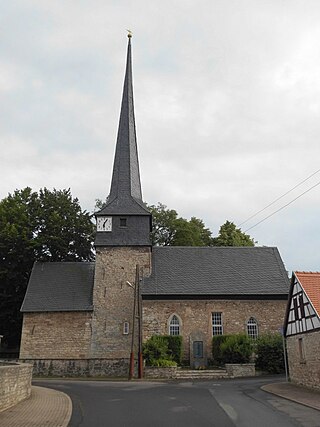
The village church of Gelmeroda is located in the Gelmeroda district of the city of Weimar in Thuringia and belongs to the Buchfart-Legefeld parish association in the Weimar church district of the Evangelical Church in Central Germany.
33. Sankt Maria Königin der Apostel
The Roman Catholic branch church of Mary Queen of the Apostles is located in Oberweimar in the Thuringian city of Weimar. It is a branch church of the parish Herz Jesu Weimar in the Weimar deanery of the Diocese of Erfurt. She bears the patronage of Mary Queen of the Apostles.
34. Schloss Tiefurt
Tiefurt House is a small stately home on the Ilm river in the Tiefurt quarter of Weimar, about 4 km east of the city centre. It was the summer residence of duchess Anna Amalia of Brunswick-Wolfenbüttel. Because of its importance as a centre of culture during the Weimar Classicism movement of the late 18th and early 19th centuries, the Tiefurt House was inscribed on the UNESCO World Heritage List in 1998 as part of the Classical Weimar site.
35. Kaiserlinden
Not far west of the Ettersberg settlement on the Großer Ettersberg, not far from the Rautenschlag nature plot, a group of 26 lime trees, called Kaiserlinden, was planted in 1817 in memory of a hunt on 8 October 1808.
36. Goethe-National-Museum/Goethes Wohnhaus

The Goethe-Nationalmuseum is a museum devoted to the German author Johann Wolfgang von Goethe, in the town of Weimar in Germany. Originally comprising the Goethe House, where Goethe lived intermittently for 50 years from 1782 to 1832, the museum was founded on 8 August 1885 as a result of the will of Goethe's last living heir, his grandson Walther von Goethe, who left the Goethe House to the state.
37. Sankt Peter und Paul
The Protestant Church of St. Peter and Paul is located in the Oberweimar district of the city of Weimar in Thuringia. It belongs to the parish of Oberweimar-Ehringsdorf in the Weimar church district of the Evangelical Church in Central Germany.
38. Gärtnerei
The nursery at Belvedere near Weimar is considerably larger than that of the park on the Ilm, which is located in the area of the Liszt House, because the demand for flowers is much greater than there and cannot be met by the orangeries alone. The founding of the nursery probably took place around 1730. The court gardener Johann David Gentzsch was commissioned to create gardens in 1730. Numerous flowers were also needed for this.
39. Die Badende - Das Ei
The Bather – The Egg is a 1.4-ton egg-shaped sculpture with a height of 1.26 m and a diameter of 0.79 m, which depicts a girl's figure during bathing, in marble, from which the water trickles into a circular flat and domed basin made of cobblestones. This is set up in the middle of the square of the university campus of the Bauhaus-Universität in Weimar at Marienstraße 13–15, in an inner courtyard not far from the Mensa am Park. This ornamental fountain was created in 1983 by Hubert Schiefelbein. The square itself is covered with paving stones that are arranged in a circle around the fountain, which further enhances the effect of the fountain. The egg itself is installed in the middle of a tube, which gives the impression that this sculpture is literally floating. In 2015, this sculpture was restored.
40. St. Mauritius
The village church of St. Mauritius is located in the Niedergrunstedt district of the city of Weimar in Thuringia. It belongs to the Buchfart-Legefeld parish association in the Weimar church district of the Evangelical Church in Central Germany.
41. Große Grotte
The Great Grotto on the western southern slope of the park of Belvedere near Weimar is an artificial ruin built around 1815. Its basic body originated from the "Grotto with Water Jokes", which dates back to the reign of Duchess Anna Amalia, which was given the shape of a dilapidated chapel through which the wind howls through various expansions and conversions. An Aeolian harp once located on the balcony reinforced the impression. The design corresponds to the park architecture of the Romantic era. In a niche on the ground floor there is a wall fountain. The interior of the ground floor can be viewed through a lattice door. On the upper plateau, a gazebo offers a view of the Possenbach valley. A bridge over an arch leads up to it. In the 1970s and 1990s, their condition made safety measures necessary. In 2014, the restoration work on the Great Grotto was continued.
42. Sankt Marien
The Protestant Church of St. Mary is located in the Tröbsdorf district of the city of Weimar in Thuringia. It belongs to the parish of Weimar in the Weimar church district of the Evangelical Church in Central Germany.
43. Teehaus
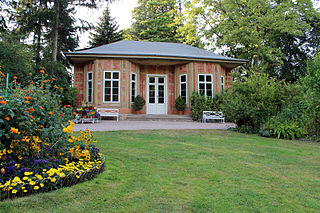
The tea house or salon in the castle park of Tiefurt was built in 1805. Previously, a bark-clad pavilion stood in its place. It has a rectangular floor plan with two angular porches in front. The large light-flooded windows and the hipped roof, which is reminiscent of Chinese models of pagoda construction, are striking. The walls consist of a half-timbered structure with brick lining. The two steps are made of sandstone. The tea salon is reminiscent of the tea party around Duchess Anna Amalia.
44. Beatae Mariae Virginis
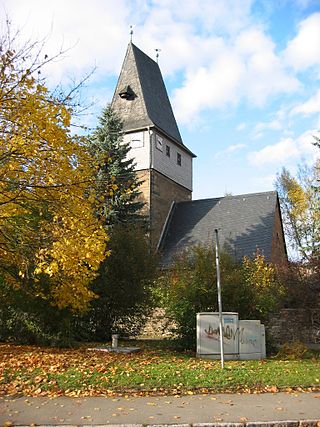
The Protestant village church Beatae Mariae Virginis, also known as St. Mary's Church, stands in the district of Ehringsdorf on the village green of the district-free city of Weimar in Thuringia. It belongs to the parish of Oberweimar-Ehringsdorf in the Weimar church district of the Evangelical Church in Central Germany.
45. Russisch Orthodoxe Kirche
The Russian Orthodox Chapel is a funerary chapel built in Weimar in 1860 for Grand Duchess Maria Pavlovna of Russia. It was constructed in the Historical Cemetery behind the Weimarer Fürstengruft, to which it is connected by an underground passage. Maria Pavlovna's coffin is located in the passage, with her husband Charles Frederick's coffin placed directly beside it. A spiral staircase leads to another underground connection to the Fürstengruft, though this is now closed by a metal plate.
46. Zu den Vierzehn Heiligen
The Protestant village church Zu den 14 Heiligen is located in the Süßenborn district of the city of Weimar in Thuringia. It belongs to the parish of Weimar in the Weimar church district of the Evangelical Church in Central Germany.
47. Fürstengruft
The Klassik Stiftung Weimar is one of the largest and most significant cultural institutions in Germany. It owns more than 20 museums, palaces, historic houses and parks, as well as literary and art collections, a number of which are World Heritage Sites.
48. St. Ursula
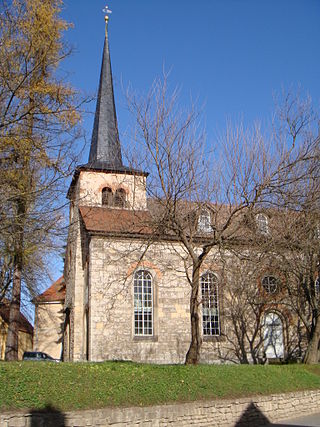
The village church of St. Ursula is located in the district of Taubach in the city of Weimar in Thuringia. It belongs to the parish of Mellingen-Umpferstedt in the Weimar church district of the Evangelical Church in Central Germany.
49. Dorfkirche St. Albanus

The Protestant village church of St. Albanus is located in the Gaberndorf district of the city of Weimar in Thuringia. It belongs to the parish of Weimar in the Weimar church district of the Evangelical Church in Central Germany.
50. Schloss Belvedere
Belvedere Palace is the former summer residence of the Dukes and Grand Dukes of Saxe-Weimar-Eisenach in the Thuringian city of Weimar. The single-wing complex was built in 1724–1748 by Duke Ernst August I of Gottfried Heinrich Krohne in the Rococo style. The Grey Salon, the West Pavilion and the Ballroom are particularly noteworthy. As part of the Ensemble Klassisches Weimar, the castle was inscribed on the UNESCO World Heritage List in 1998.
Wikipedia: Belvedere (Weimar) (DE), Website, Heritage Website
Share
Disclaimer Please be aware of your surroundings and do not enter private property. We are not liable for any damages that occur during the tours.

.jpg)
